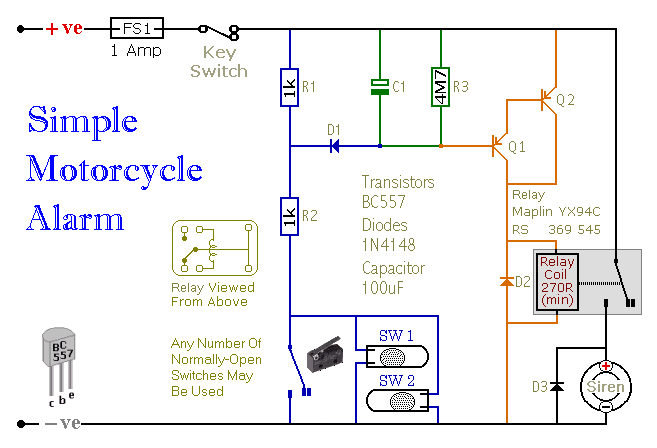
Vehicle alarm

This is a simple easy to build transistor based motorcycle alarm. It is designed to work at 12 volts. But if you change the relay for one with a 6-volt coil, it will protect your Classic Bike. The standby current is virtually zero, so it won’t drain your battery. The support material for this alarm includes a detailed guide to the construction of the circuit board, a parts list, a complete circuit description and more. Notes: Any number of normally-open switches may be used. Fit the mercury switches so that they close when the steering is moved or when the bike is lifted off its side-stand or pushed forward off its centre-stand. Use micro-switches to protect removable components.
The described motorcycle alarm system utilizes a transistor-based circuit that is powered by a 12-volt supply, making it compatible with standard motorcycle electrical systems. The core of the alarm system is a relay that can be swapped for a 6-volt coil relay, allowing for versatility in application, particularly for classic motorcycles that may operate at lower voltages.
The circuit operates with minimal standby current, ensuring that the motorcycle's battery remains charged and is not drained during periods of inactivity. This is a critical feature for motorcycle alarms, where battery life is often a concern. The design includes a detailed circuit board layout that facilitates easy assembly and troubleshooting, catering to individuals with varying levels of electronic assembly experience.
In terms of functionality, the alarm can be triggered by any number of normally-open switches, which can be strategically placed on the motorcycle. Mercury switches are suggested for use in this setup, as they can effectively detect movements such as tilting or steering adjustments. The placement of these switches is crucial; they should be oriented to close the circuit when the motorcycle is moved from its resting position, either by lifting it off the side-stand or pushing it forward from the center-stand.
Additionally, micro-switches can be integrated into the system to safeguard removable components, providing an extra layer of security. These switches can be activated when components such as seats or storage compartments are accessed, further enhancing the alarm's protective capabilities.
Overall, the simplicity of the design combined with its effective security features makes this transistor-based motorcycle alarm an accessible and reliable option for motorcycle owners seeking to enhance the security of their vehicles.This is a simple - easy to build - transistor based motorcycle alarm. It`s designed to work at 12-volts. But - if you change the relay for one with a 6-volt coil - it`ll protect your "Classic Bike". The standby current is virtually zero - so it won`t drain your battery. The Support material for this alarm includes a detailed guide to the construction of the circuit-board, a parts list, a complete circuit description and more. Notes: Any number of normally-open switches may be used. Fit the mercury switches so that they close when the steering is moved or when the bike is lifted off its side-stand or pushed forward off its centre-stand. Use micro-switches to protect removable 🔗 External reference
The described motorcycle alarm system utilizes a transistor-based circuit that is powered by a 12-volt supply, making it compatible with standard motorcycle electrical systems. The core of the alarm system is a relay that can be swapped for a 6-volt coil relay, allowing for versatility in application, particularly for classic motorcycles that may operate at lower voltages.
The circuit operates with minimal standby current, ensuring that the motorcycle's battery remains charged and is not drained during periods of inactivity. This is a critical feature for motorcycle alarms, where battery life is often a concern. The design includes a detailed circuit board layout that facilitates easy assembly and troubleshooting, catering to individuals with varying levels of electronic assembly experience.
In terms of functionality, the alarm can be triggered by any number of normally-open switches, which can be strategically placed on the motorcycle. Mercury switches are suggested for use in this setup, as they can effectively detect movements such as tilting or steering adjustments. The placement of these switches is crucial; they should be oriented to close the circuit when the motorcycle is moved from its resting position, either by lifting it off the side-stand or pushing it forward from the center-stand.
Additionally, micro-switches can be integrated into the system to safeguard removable components, providing an extra layer of security. These switches can be activated when components such as seats or storage compartments are accessed, further enhancing the alarm's protective capabilities.
Overall, the simplicity of the design combined with its effective security features makes this transistor-based motorcycle alarm an accessible and reliable option for motorcycle owners seeking to enhance the security of their vehicles.This is a simple - easy to build - transistor based motorcycle alarm. It`s designed to work at 12-volts. But - if you change the relay for one with a 6-volt coil - it`ll protect your "Classic Bike". The standby current is virtually zero - so it won`t drain your battery. The Support material for this alarm includes a detailed guide to the construction of the circuit-board, a parts list, a complete circuit description and more. Notes: Any number of normally-open switches may be used. Fit the mercury switches so that they close when the steering is moved or when the bike is lifted off its side-stand or pushed forward off its centre-stand. Use micro-switches to protect removable 🔗 External reference





